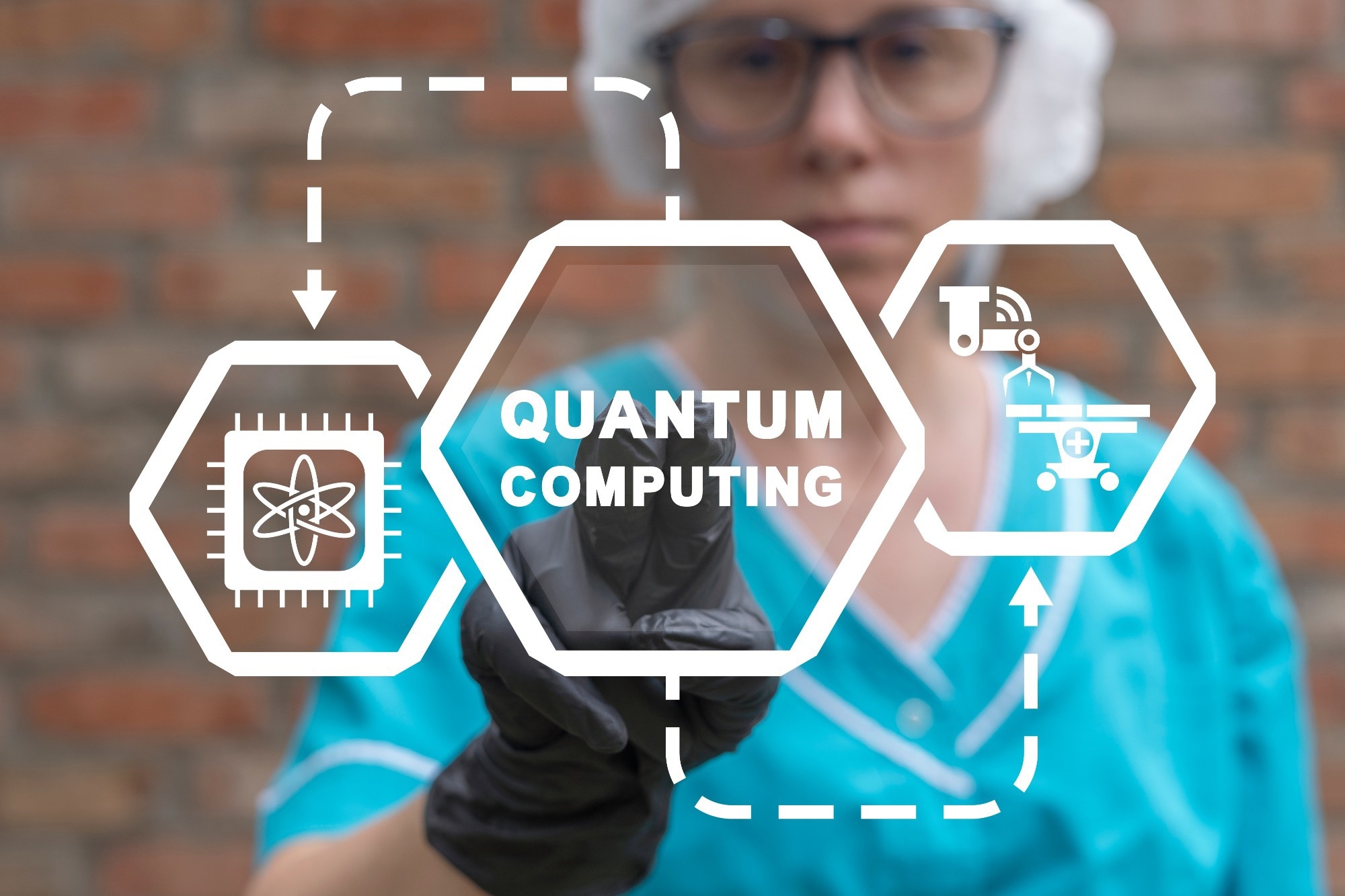 By Samudrapom DamReviewed by Susha Cheriyedath, M.Sc.Updated on Sep 30 2024
By Samudrapom DamReviewed by Susha Cheriyedath, M.Sc.Updated on Sep 30 2024Quantum computing is an emerging field that utilizes quantum mechanics concepts to perform computations. This new kind of computing deals with the physical world, which is unpredictable and probabilistic in nature, and can solve problems that cannot be solved by classical computing.1,2

Image Credit: Panchenko Vladimir/Shutterstock.com
Quantum computing exists at the intersection of physics, computer science, and mathematics. At its core are quantum bits (qubits), which are subatomic particles such as ions, photons, electrons, or atoms that can store and manipulate information. What sets qubits apart from classical bits is their ability to exist in multiple states simultaneously, a phenomenon known as superposition. This allows quantum computers to explore a vast number of computational paths at once, making them exponentially faster in solving certain types of problems.
In addition, quantum computers use entanglement, another key principle of quantum mechanics, which allows qubits to be interconnected in such a way that the state of one qubit is directly related to the state of another, even over large distances. This interconnectedness enables highly efficient parallel computations, significantly enhancing processing power. The capacity of quantum computing to perform such operations challenges classical computing limitations, which posits that a classical computer cannot efficiently solve all problems a quantum computer can handle.
Quantum computing's potential to revolutionize fields like cryptography, optimization, and material science is profound, offering solutions to problems that would take classical computers impractically long periods to solve.1,2
Quantum Computing 101: How It Works and Why It Matters for the Future
The Quantum Bit (Qubit)
At the core of quantum computing lies the qubit, which serves as the quantum counterpart to the classical binary bit. While classical bits are limited to either 0 or 1 states at any given time, qubits have the ability to exist in both states simultaneously through superposition. This capability allows qubits to perform operations in parallel, dramatically enhancing computational efficiency and speed compared to classical systems.
Among the various materials being explored for qubit development, semiconductors are emerging as the leading option for building scalable quantum computers. Qubits also enable the construction of quantum networks, which operate between end nodes. For these networks to function, qubits must undergo quantum entanglement—a process where entangled qubits become indistinguishable and share a continuum of states.
This entanglement enables the entire quantum network to act as a unified system, improving the efficiency of data transfer and storage. The manipulation of electron spin and photon polarization between qubits is key to managing data in these networks, ensuring more secure and efficient communication. As quantum computing and networking technologies evolve, the qubit's ability to process and transmit information at unprecedented scales will play a transformative role in industries dependent on data-intensive processes.3
Quantum Entanglement
Quantum entanglement between qubits allows them to remain interconnected over vast distances. When a quantum network is measured, the properties of the entangled qubits are simultaneously affected, meaning that even though individual qubits within a network may have different properties, they collectively hold and share the same information. This makes quantum networks highly efficient and powerful for data analysis and transfer.
One key application of this phenomenon is quantum teleportation, where data is transmitted by manipulating electrons and photons, similar to the way entanglement works. Quantum networks are typically anchored by nodes at either end, which can be composed of various components such as quantum processors, beamsplitters, photodetectors, telecommunication lasers, quantum logic gates, or ion traps.
In addition to qubits, building a functional quantum computer requires a robust physical infrastructure. Two critical components are communication channels and quantum repeaters. Communication channels serve as the pathways through which qubits interact, utilizing either free-space networks or fiber optic cables to transmit single photons. Quantum repeaters play an essential role in maintaining signal integrity over long distances, ensuring that the data transferred does not degrade or break down. Due to the complexity of quantum signals, maintaining a stable connection requires more sophisticated infrastructure than classical networks.
Quantum repeaters, in particular, are critical to extending the range of quantum communication, as they help prevent signal loss, making large-scale, long-distance quantum networks feasible for a variety of advanced applications such as secure communications and high-speed data processing.3
Quantum Computing Types
Quantum computing can be divided into several categories based on the methods used to implement qubits and process quantum information. The major types include superconducting circuits, trapped ions, topological quantum computing, quantum dots, and photonic quantum computing. Each approach has distinct advantages and challenges, making them suitable for different applications.1
-
Superconducting Circuits: In the current noisy-intermediate-scale-quantum (NISQ) era, superconducting circuits are the leading technology for quantum computing. Companies such as Google, IBM, Alibaba, Intel, and Rigetti are heavily investing in this area. Superconducting qubits are created using superconducting circuits cooled to extremely low temperatures to allow the quantum states to function with minimal interference. This approach is known for its relatively fast operation speeds and scalability potential, making it a key focus in both research and commercial development.
-
Trapped Ions: This approach involves trapping ions in an electromagnetic field, where the energy levels of their intrinsic spin represent the qubit states. Lasers are used to manipulate these qubits, allowing precise control over quantum operations. Trapped ions are highly stable and exhibit low error rates, making them a strong candidate for developing practical quantum computers. This technology is particularly suitable for simulating complex quantum systems, such as condensed matter physics, high-energy physics, and cosmology.
Other approaches, such as topological quantum computing, quantum dots, and photonic quantum computing, are also being explored, each offering unique benefits. For example, topological quantum computing promises robustness against errors, while photonic quantum computing is known for its potential in long-distance quantum communication.
As different quantum computing technologies continue to advance, they offer diverse solutions for industries ranging from cryptography and optimization to fundamental physics simulations, positioning quantum computing as a transformative technology of the future.1
Quantum Computing and the IoT
Quantum Computing Algorithms
Quantum computing employs a variety of algorithms that offer significant speedups and advantages over classical computing methods. Below are some of the key algorithms:
-
Grover's Algorithm: Grover's algorithm provides a quadratic speed-up over classical algorithms, particularly in unstructured data-search tasks. It is widely used for searching unsorted databases more efficiently. A combination of Grover's algorithm with classical approaches, such as in 3SAT problem-solving, can greatly accelerate problem-solving capabilities.
-
Quantum Error Mitigation Approaches: As quantum computing, especially in the NISQ era, faces challenges from noise and errors, several error mitigation strategies have been developed. Unlike error correction, which requires additional physical qubits, error mitigation methods, such as quasi-probability decomposition and error extrapolation, do not.
- Quasi-Probability Decomposition: This method rewrites noiseless quantum circuits in terms of a mixture of noisy circuits. Using the Monte Carlo method, it estimates expectation values, allowing for better error handling.
- Error Extrapolation: This technique analyzes the impact of noise on expectation values, predicting how noise affects the outcome and compensating for it in experimental data, improving the accuracy of results.
-
Hybrid Quantum-Classical Algorithms: Given the limitations of current quantum computers, hybrid quantum-classical algorithms have become essential in the NISQ era. These algorithms use quantum mechanics alongside classical computations to solve complex problems.
- Variational Quantum Eigensolver (VQE): VQE is robust against noise and suitable for NISQ devices. It has been used to calculate molecular properties, making it particularly relevant for quantum chemistry.
- Quantum Approximate Optimization Algorithm (QAOA): Extensively used for optimization tasks, QAOA addresses the problem of optimizing an objective function by iterating through a classical process, combined with quantum operations.
-
Quantum Adiabatic Optimization and Quantum Annealing: These hybrid algorithms focus on combinatorial optimization problems.
- Quantum Annealing leverages the principle of superposition to escape local minima, making it effective for problems with complex landscapes that are difficult to solve with classical algorithms like simulated annealing. Quantum annealing is particularly valuable in industries like finance, where optimization is crucial for tasks such as portfolio management, cost control, and pricing.
These quantum algorithms represent significant advances in fields such as optimization, data analysis, and error management, laying the foundation for future applications of quantum computing across industries.4
Quantum-Inspired Classical Algorithms for Molecular Vibronic Spectra
Commercial Outlook
Quantum computing has garnered significant interest from leading organizations such as HP, Mitsubishi, Intel, Lockheed Martin, Google, Microsoft, IBM, and Airbus. These companies are making substantial investments in research and development, with funding in quantum computing reaching $10.7 billion by 2024. Among the ambitious projects in the quantum space, IBM has set a goal to develop a 1 million-qubit quantum computer by 2030. Recently, IBM unveiled its 1121-qubit quantum computer, known as IBM Condor, marking a major milestone in quantum hardware development.5
In summary, quantum computing holds tremendous potential for solving complex problems that are beyond the capabilities of classical computers. As technological advancements continue, we can expect more groundbreaking applications to emerge across industries, ranging from cryptography and optimization to material science and healthcare.
References and Further Reading
- Hassija, V. et al. (2020). Present landscape of quantum computing. IET Quantum Communication, 1(2), 42-48. DOI: 10.1049/iet-qtc.2020.0027, https://ietresearch.onlinelibrary.wiley.com/doi/full/10.1049/iet-qtc.2020.0027
- Marella, S. T., Parisa, H. S. K. (2020). Introduction to quantum computing. Quantum Computing and Communications. DOI: 10.5772/intechopen.94103, https://www.intechopen.com/chapters/73811
- Caleffi M. et al. Quantum Internet: from Communication to Distributed Computing, NANOCOM '18 Proceedings of the 5th ACM International Conference on Nanoscale Computing and Communication, 2018, DOI: 10.1145/3233188.3233224, https://arxiv.org/abs/1805.04360
- Cho, C. et al. (2021). Quantum computation: Algorithms and Applications. Chinese Journal of Physics, 72, 248-269. DOI: 10.1016/j.cjph.2021.05.001, https://www.sciencedirect.com/science/article/abs/pii/S0577907321001039
- Introduction to Quantum Computers [Online] Available at https://help.rc.unc.edu/Assets/New_Course_Material/General_Computing/Introduction_to_Quantum_Computers.pdf
Disclaimer: The views expressed here are those of the author expressed in their private capacity and do not necessarily represent the views of AZoM.com Limited T/A AZoNetwork the owner and operator of this website. This disclaimer forms part of the Terms and conditions of use of this website.